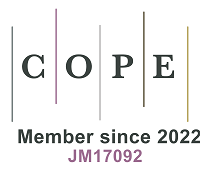REFERENCES
1. Chen Y, Yang J, Yao B, Zhi D, Luo L, Zhou Y. Endocrine disrupting chemicals in the environment: Environmental sources, biological effects, remediation techniques, and perspective. Environ Pollut 2022;310:119918.
2. Gorence GJ, Pulcastro HC, Lawson CA, et al. Chemical contaminants from plastics in the animal environment. J Am Assoc Lab Anim Sci 2019;58:190-6.
3. Liu J, Zhang L, Lu G, Jiang R, Yan Z, Li Y. Occurrence, toxicity and ecological risk of Bisphenol A analogues in aquatic environment - a review. Ecotoxicol Environ Saf 2021;208:111481.
4. Diamanti-Kandarakis E, Bourguignon JP, Giudice LC, et al. Endocrine-disrupting chemicals: an endocrine society scientific statement. Endocr Rev 2009;30:293-342.
5. Hotchkiss AK, Rider CV, Blystone CR, et al. Fifteen years after "wingspread"--environmental endocrine disrupters and human and wildlife health: where we are today and where we need to go. Toxicol Sci 2008;105:235-59.
6. Noszczyńska M, Piotrowska-Seget Z. Bisphenols: application, occurrence, safety, and biodegradation mediated by bacterial communities in wastewater treatment plants and rivers. Chemosphere 2018;201:214-23.
7. Russo G, Capuozzo A, Barbato F, Irace C, Santamaria R, Grumetto L. Cytotoxicity of seven bisphenol analogues compared to bisphenol A and relationships with membrane affinity data. Chemosphere 2018;201:432-40.
8. Zainuddin AH, Roslan MQJ, Razak MR, Yusoff FM, Haron DEM, Aris AZ. Occurrence, distribution, and ecological risk of bisphenol analogues in marine ecosystem of urbanized coast and estuary. Mar Pollut Bull 2023;192:115019.
9. Di Bella G, Porretti M, Cafarelli M, et al. Screening of phthalate and non-phthalate plasticizers and bisphenols in Sicilian women's blood. Environ Toxicol Pharmacol 2023;100:104166.
10. Xue J, Kannan K. Mass flows and removal of eight bisphenol analogs, bisphenol A diglycidyl ether and its derivatives in two wastewater treatment plants in New York State, USA. Sci Total Environ 2019;648:442-9.
11. Karthikraj R, Kannan K. Mass loading and removal of benzotriazoles, benzothiazoles, benzophenones, and bisphenols in Indian sewage treatment plants. Chemosphere 2017;181:216-23.
12. Sun Q, Wang Y, Li Y, et al. Fate and mass balance of bisphenol analogues in wastewater treatment plants in Xiamen city, China. Environ Pollut 2017;225:542-9.
13. Zhao JL, Huang Z, Zhang QQ, et al. Distribution and mass loads of xenoestrogens bisphenol a, 4-nonylphenol, and 4-tert-octylphenol in rainfall runoff from highly urbanized regions: a comparison with point sources of wastewater. J Hazard Mater 2021;401:123747.
14. Huang Z, Zhao JL, Yang YY, et al. Occurrence, mass loads and risks of bisphenol analogues in the Pearl River Delta region, South China: urban rainfall runoff as a potential source for receiving rivers. Environ Pollut 2020;263:114361.
15. Huang Z, Zhao JL, Zhang CY, et al. Profile and removal of bisphenol analogues in hospital wastewater, landfill leachate, and municipal wastewater in South China. Sci Total Environ 2021;790:148269.
17. Wang H, Liu ZH, Tang Z, et al. Bisphenol analogues in Chinese bottled water: Quantification and potential risk analysis. Sci Total Environ 2020;713:136583.
18. Zhang H, Zhang Y, Li J, Yang M. Occurrence and exposure assessment of bisphenol analogues in source water and drinking water in China. Sci Total Environ 2019;655:607-13.
19. Brodin T, Piovano S, Fick J, Klaminder J, Heynen M, Jonsson M. Ecological effects of pharmaceuticals in aquatic systems--impacts through behavioural alterations. Philos Trans R Soc Lond B Biol Sci 2014;369:20130580.
20. Boxall AB, Rudd MA, Brooks BW, et al. Pharmaceuticals and personal care products in the environment: what are the big questions? Environ Health Perspect 2012;120:1221-9.
21. Lv YZ, Yao L, Wang L, et al. Bioaccumulation, metabolism, and risk assessment of phenolic endocrine disrupting chemicals in specific tissues of wild fish. Chemosphere 2019;226:607-15.
22. Ismail NAH, Wee SY, Aris AZ. Bisphenol A and alkylphenols concentrations in selected mariculture fish species from Pulau Kukup, Johor, Malaysia. Mar Pollut Bull 2018;127:536-40.
23. Lei H, Yao K, Yang B, Xie L, Ying G. Occurrence, spatial and seasonal variation, and environmental risk of pharmaceutically active compounds in the Pearl River basin, South China. Front Environ Sci Eng 2023;17:46.
24. Wang S, Ni J, Wang G, Cheng D, Zhang O. Hydrological processes of an anastomosing river system on the Zhujiang River Delta, China. J Coast Res 2004:124-33. Available from: https://www.jstor.org/stable/25737029 [Last accessed on 16 Oct 2023]
25. Wang Y, Wen Y, Li JJ, et al. Investigation on the relationship between bioconcentration factor and distribution coefficient based on class-based compounds: the factors that affect bioconcentration. Environ Toxicol Pharmacol 2014;38:388-96.
26. Tolls J, Haller M, de Graaf I, Thijssen MATC, Sijm DTHM. Bioconcentration of LAS: experimental determination and extrapolation to environmental mixtures. Environ Sci Technol 1997;31:3426-31.
27. Boonsaner M, Hawker DW. Evaluation of food chain transfer of the antibiotic oxytetracycline and human risk assessment. Chemosphere 2013;93:1009-14.
28. Subedi B, Du B, Chambliss CK, et al. Occurrence of pharmaceuticals and personal care products in German fish tissue: a national study. Environ Sci Technol 2012;46:9047-54.
29. Hu Z, Shi Y, Cai Y. Reprint of: Concentrations, distribution, and bioaccumulation of synthetic musks in the Haihe River of China. Chemosphere 2011;85:262-7.
30. Cousins I, Staples C, Kleĉka G, Mackay D. A multimedia assessment of the environmental fate of bisphenol A. Hum Ecol Risk Assess 2002;8:1107-35.
31. Xia F, Shen Y, Yan J, BaoHXH. On the potential of urban three-dimensional space development: the case of Liuzhou, China. Habitat Int 2016;51:48-58.
32. Kelly BC, Ikonomou MG, Blair JD, Morin AE, Gobas FA. Food web-specific biomagnification of persistent organic pollutants. Science 2007;317:236-9.
33. Memmert U, Peither A, Burri R, et al. Diclofenac: New data on chronic toxicity and bioconcentration in fish. Environ Toxicol Chem 2013;32:442-52.
34. Liu YH, Lv YZ, Huang Z, et al. Uptake, elimination, and toxicokinetics of selected pharmaceuticals in multiple tissues of Nile tilapia (Oreochromis niloticus) exposed to environmentally relevant concentrations. Ecotoxicol Environ Saf 2021;226:112874.
35. Liu YH, Yao L, Huang Z, et al. Enhanced prediction of internal concentrations of phenolic endocrine disrupting chemicals and their metabolites in fish by a physiologically based toxicokinetic incorporating metabolism (PBTK-MT) model. Environ Pollut 2022;314:120290.
36. Wang Q, Chen M, Shan G, et al. Bioaccumulation and biomagnification of emerging bisphenol analogues in aquatic organisms from Taihu Lake, China. Sci Total Environ 2017;598:814-20.
37. Ramirez AJ, Brain RA, Usenko S, et al. Occurrence of pharmaceuticals and personal care products in fish: results of a national pilot study in the United States. Environ Toxicol Chem 2009;28:2587-97.
38. Lange C, Kuch B, Metzger JW. Occurrence and fate of synthetic musk fragrances in a small German river. J Hazard Mater 2015;282:34-40.
39. Dann AB, Hontela A. Triclosan: environmental exposure, toxicity and mechanisms of action. J Appl Toxicol 2011;31:285-311.







